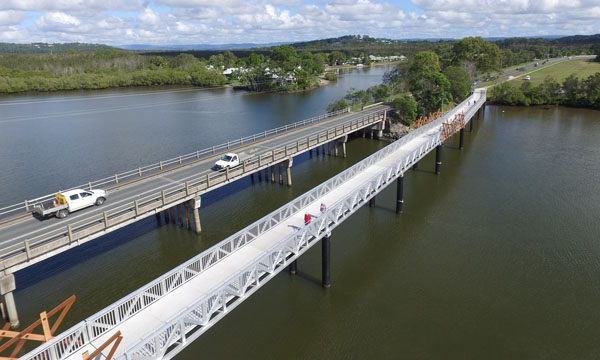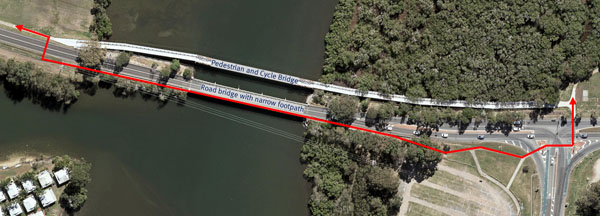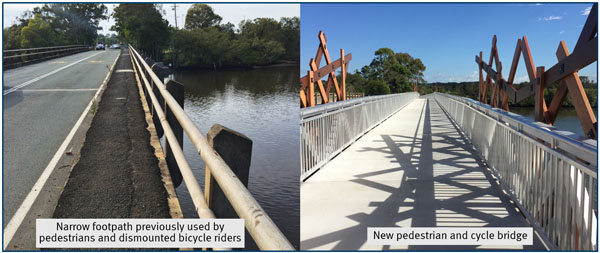Eudlo Creek Bridge
The Eudlo Creek Bridge is a shared pathway for bicycle riders and pedestrians across the Eudlo Creek between Maroochydore and Bli Bli on the Sunshine Coast.

Image credit: Sunshine Coast Regional Council
The 3m wide, stand-alone bridge completes a missing link in the cycle network by providing a dedicated cycle path along David Low Way to Bli Bli. It replaces the footway on the existing vehicle bridge, providing a safer crossing alternative for people walking and bike riding.
Key facts
- 320m long, 3m wide shared path crossing the Eudlo Creek, separate from the road bridge.
- In 2017, around 140 pedestrians and bike riders used the bridge each week day and as many as 280 per day on the weekend.
- Opened in May 2017 at a total cost of $2.98m funded jointly by the Queensland Government and Sunshine Coast Regional Council.
Benefits
The Eudlo Creek Bridge provides a high-quality connection between 2 existing shared pathways on either side of the waterway.
Prior to the separated bridge and pathway, pedestrians and bicycle riders had to cross the road (shown below), use the motor vehicle bridge alongside traffic, and then cross the road again. The footpath across the road bridge was narrow and provided very little separation between people walking and motor vehicles.
Pedestrian and off-road bicycle rider route prior to the Eudlo Creek Bridge

© State of Queensland 2018
Bicycle riders were legally required to use the 60 km/h single-lane roadway or had to dismount to use the ‘pedestrian-only’ 1.0 m wide narrow footpath. There were bicycle awareness zone markings present to remind motorists of the presence of people on bicycles but riders were unable to avoid travelling with cars and trucks.
Before and after

Image credit: Sunshine Coast Regional Council
The new Eudlo Creek pedestrian and cycle bridge opened in May 2017 at a total cost of $2.98m funded jointly by the Queensland Government and Sunshine Coast Regional Council. The bridge provides a superior experience for people riding bicycles and makes their journey faster, safer and more pleasant. The bridge makes possible more bicycle riding journeys, particularly for those riders who do not feel comfortable mixing with high volumes of traffic at moderate speeds.1
Bicycle riding journey over the Eudlo Creek Bridge
Insights
Video-based manual counts and intercept surveys of pathway users undertaken in late 20171 revealed:
- The bridge is predominantly being used for recreation rather than commuting with 80% of people surveyed travelling for recreation or exercise.
- The bridge is encouraging some bicycle riding and walking that would have not otherwise occurred, with around 10% of people surveyed saying they would not have ridden or walked had the bridge not been there.
- Around a third of people surveyed indicated they had increased the amount of walking and/or bicycle riding because of the bridge, indicating a positive shift in healthy activity.
The Eudlo Creek Pedestrian and Cycle Bridge was constructed using an innovative design that utilises lightweight materials. This design allowed a significant length of elevated pathway to be constructed for a fraction of the cost of traditional concrete bridges.
Location of the Eudlo Creek Pedestrian and Cycle Bridge
View fullscreen map through external site Bike citizens | Access online maps provided by the Sunshine Coast Regional Council
Routes are suggested only. You are responsible for your own safety while using Queensland’s bikeway network. The Department accepts no responsibility for any incorrect or out of date data presented.
More information
For more information, please contact the Cycling and Programs team by emailing Cycling_Infrastructure_Program@tmr.qld.gov.au.
1 CDM Research. 2018. Evaluation of the Eudlo Creek Cycle and Pedestrian Bridge. Report prepared for Queensland Department of Transport and Main Roads. Available on our Infrastructure benefit evaluations page.
- Last updated 07 September 2023

